19 July – 18 August 1950
Symbolic Realism in American Painting 1940–1950
Institute of Contemporary Arts, London
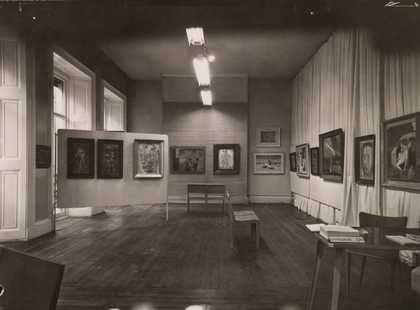
Installation view of the exhibition Symbolic Realism in American Painting 1940–1950 at the Institute for Contemporary Arts, London, 1950
Tate Archive TGA 955/1/12/19
Photo © Tate
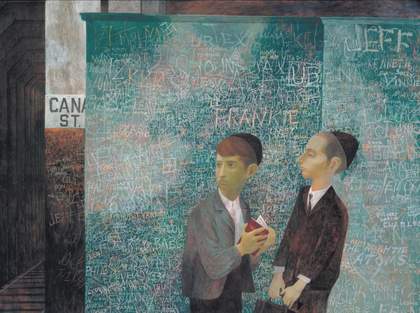
Bernard Perlin
Orthodox Boys 1948
Tate N05956
© Bernard Perlin
Organised by the critic and collector Lincoln Kirstein, this exhibition was first shown at the Edwin Hewitt Gallery in New York before travelling to London.1 It aimed to highlight for critical consideration the work of Bernard Perlin, Paul Cadmus and other figurative artists in light of the emergence of abstract painters championed by the critic Clement Greenberg, foremost among whom was Jackson Pollock.
While in London (where the exhibition was received far more favourably than in New York), Kirstein donated one of the works, Perlin’s Orthodox Boys 1948 (not included in the New York showing) to the Tate Gallery. It was the first work of post-war American art to enter Tate’s collection.
28 January – 28 February 1953
Jackson Pollock’s painting One: Number 31 1950 1950 is shown in Opposing Forces at the Institute of Contemporary Arts, London
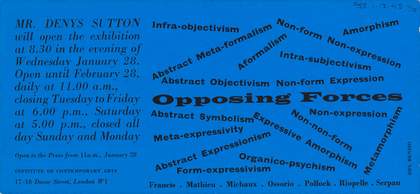
Invitation to the private view of the exhibition Opposing Forces, Institute of Contemporary Arts, London, 1953. The invitation was designed by the artist Tony del Renzio.
Tate Archive TGA 955/1/12/45
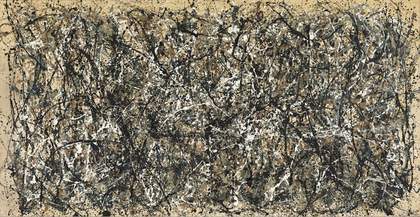
Jackson Pollock
One: Number 31, 1950 1950
Museum of Modern Art, New York
© 2017 Pollock-Krasner Foundation
Pollock’s One: Number 31 1950 was the first of his paintings to be exhibited in Britain. It arrived from Switzerland only after the exhibition Opposing Forces had opened at the Institute of Contemporary Arts. The critic David Sylvester recalled, ‘the canvas was too big for the gallery and had to be hung partly rolled’.2 Several critics were outraged at Pollock’s work but Robert Melville, writing in Architectural Review, saw in it a ‘majestic turmoil’ and a ‘strangely restful image of human restlessness’.3
Paintings by Pollock were later included in Tate’s exhibition Modern Art in the United States in 1956, but it was not until his 1958 solo show at the Whitechapel Gallery that British audiences were able to see a broad and representative selection of his work.
14 March – 30 April 1953
The Unknown Political Prisoner
Tate Gallery
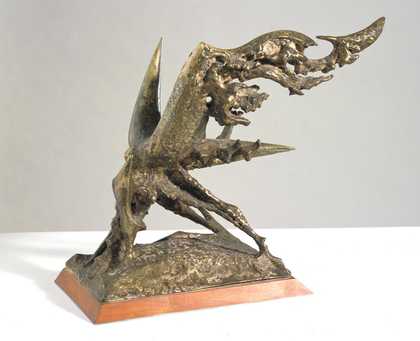
Theodore Roszak
The Unknown Political Prisoner (Defiant and Triumphant) 1952
Tate N06163
© Theodore Roszak
With funds provided by an anonymous American donor (later revealed to be the American businessman and diplomat John Hay Whitney), the Institute of Contemporary Arts (ICA) organised an international competition for a monument dedicated to the ‘Unknown Political Prisoner’. The initiative attracted entries from 3,500 artists from fifty-seven countries. After national juries made a preliminary selection, 140 maquettes for the proposed monument were shown at the Tate Gallery. These included eleven American entries, shown at the Museum of Modern Art (MoMA) in New York before coming to London.
Tate acquired several maquettes from the exhibition, including The Unknown Political Prisoner (Defiant and Triumphant) 1952 by Theodore Roszak.4 MoMA’s then Director of Collections Alfred Barr travelled to London as one of the jurors for the competition, and gave a lecture on the politics of modernism at the ICA titled ‘They Hate Modern Art or Patterns of Philistine Power’.5
4 May – 4 June 1955
Mark Tobey: Paintings and Drawings
Institute of Contemporary Arts, London
With this exhibition, in which his ‘white writing’ works were first shown in Britain, Mark Tobey became, as the critic Lawrence Alloway later reflected, ‘the first modern of stature to have a personal show in London’.6
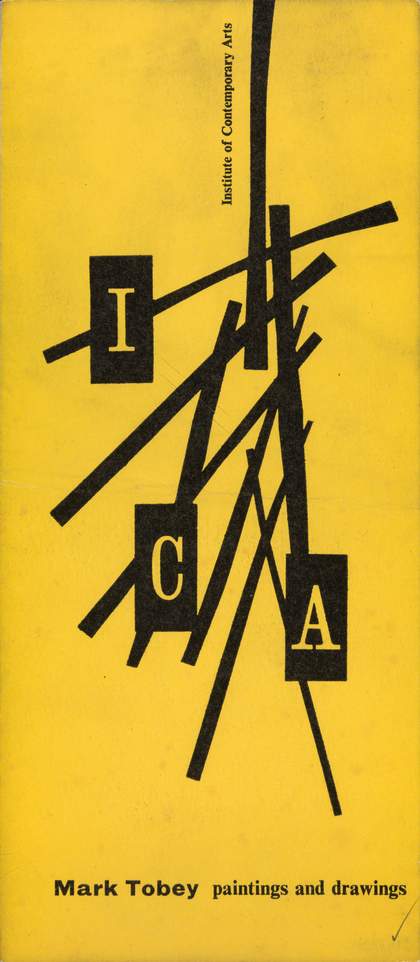
Cover of Mark Tobey, Paintings and Drawings, exhibition catalogue, Institute of Contemporary Arts, London 1955
During the 1930s Tobey taught in Dartington Hall, Devon, and travelled widely in Europe, South America, the Middle East and the Far East. He enjoyed early successes and as his work moved towards abstraction, his relation to his peers became, according to Alloway, that of ‘a forerunner as well as a contemporary’,7 and he is known to have influenced Pollock’s development of ‘all-over’ painting. In 1958 he became the second American painter, after Whistler, to win the International Grand Prize at the Venice Biennale.
5 January – 12 February 1956
Modern Art in the United States: A Selection from the Collections of the Museum of Modern Art, New York
Tate Gallery
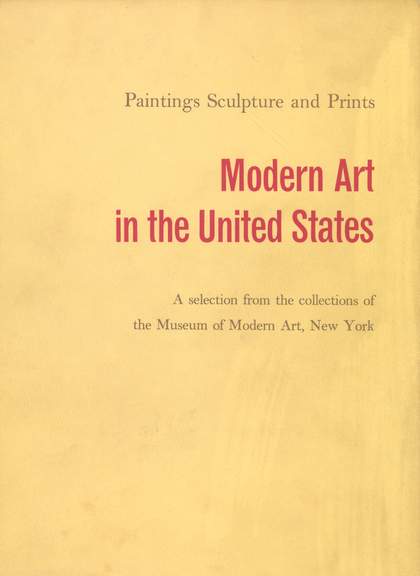
Cover of Modern Art in the United States: A Selection from the Collections of the Museum of Modern Art, New York, exhibition catalogue, Tate Gallery, London 1956
Modern Art in the United States, like many exhibitions of American art in Britain that followed, was organised as a touring exhibition by the Museum of Modern Art in New York in conjunction with the Arts Council. As John Rothenstein and Philip James wrote in their catalogue introduction, the exhibition differed from the 1946 show American Painting from the Eighteenth Century to the Present Day in its focus on twentieth-century work. The final room contained works by the abstract expressionists, which with few exceptions (such as the one painting by Jackson Pollock in Opposing Forces), had rarely been seen in Britain.8
Some critics were hostile. John Russell (later art critic of the New York Times) described Pollock as ‘slapping the huge canvas with his own paint-covered hands’ and added, ‘I don’t think that, in this case, it was the canvas that deserved the slaps’.9 On the other hand, David Sylvester, who had previously been sceptical about US art, experienced what he described as a ‘Damascene conversion’ upon visiting the exhibition, writing, ‘The Americans, indeed, seem to have solved as a matter of course one of the problems which most preoccupy painters everywhere today – the problem of avoiding a gratuitous beauty or charm without at once producing its opposite.’10
22 September – 20 October 1956
John Marin: Paintings, Water-colours, Drawings, and Etchings
Arts Council Gallery, London
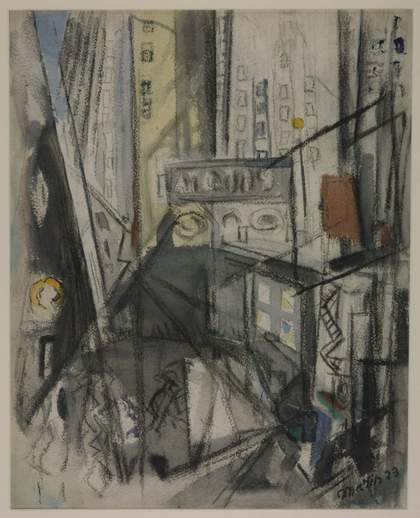
John Marin
Downtown, New York 1923
Watercolour on paper
Tate T00080
© reserved
This memorial exhibition, held three years after the death of the artist, demonstrated affinities between John Marin’s painting and the British landscape tradition. In his foreword, Philip James of the Arts Council suggested that of all the media used by Marin, ‘it is perhaps his water-colours which will make the greatest impact since he had a real mastery of this medium for which we English have an instinctive sympathy’.11 Frederick Laws of the Manchester Guardian wrote that Marin’s ‘preoccupation with sail [sic]’ had ‘the haunted quality’ of St Ives artist Alfred Wallis.12
The Tate Gallery purchased Marin’s watercolour Downtown, New York 1923 in the same year, using money made available by the Bruern Foundation for the purchase of an example of American painting or sculpture.13
15 April – 26 May 1957
Paintings from the Solomon R. Guggenheim Museum
Tate Gallery
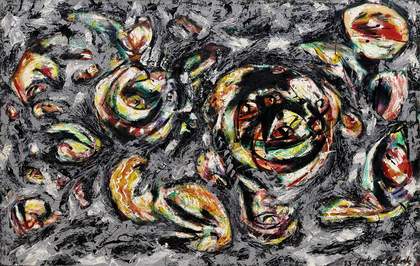
Jackson Pollock
Ocean Greyness 1953
Oil on canvas
Solomon R. Guggenheim Museum, New York
© 2019 The Pollock-Krasner Foundation/Artists Rights Society (ARS), New York
The selection of works for Paintings from the Solomon R. Guggenheim Museum was made by the Guggenheim’s director, James Johnson Sweeney. It was the first time that the American museum, founded in 1937, had sent an exhibition of its paintings to Europe. The show coincided with An Exhibition of Paintings from the Musée d’Art Moderne, Paris (Royal Society of British Artists Galleries, London, 13 April – 18 May), offering a comparison of the holdings of the two museums.
The Guggenheim exhibition presented an overview of modern painting, from Seurat and Cézanne to abstract expressionism, and included recent works by several leading American artists. Many critics praised the earlier European works, while denigrating the more recent abstract paintings. John Russell writing in the Sunday Times accepted the ‘individual power’ of Jackson Pollock’s Ocean Greyness 1953 but wrote that ‘the Franz Kline, the Stuart Davis, the Carl Morris, these are sad tosh, and a poor end to an exhibition that begins so marvellously well’.14
16 May – 8 June 1957
Sam Francis: Oil Paintings and Watercolours
Gimpel Fils, London
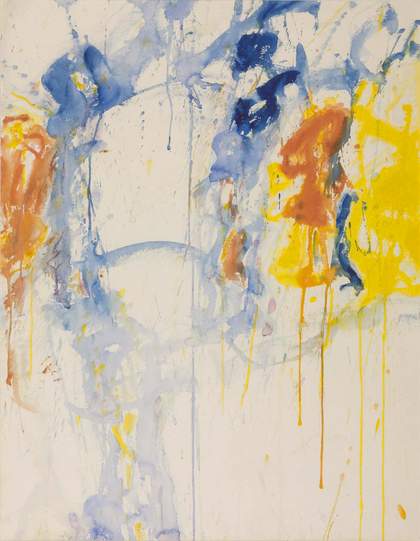
Sam Francis
Painting 1957
Tate T00148
© Estate of Sam Francis/ ARS, NY & DACS, London 2019
Resident in Paris during the 1950s, Sam Francis’s geographical proximity helped to establish his reputation in Britain. This exhibition at Gimpel Fils featured a catalogue essay by the influential critic Herbert Read who wrote, ‘Sam Francis must not be confused with those “action-painters” who hope to achieve greatness by riding their brushes as if they were witches’ brooms’.15 The following year Francis would be included in the exhibition Abstract Impressionism which brought together a group of similarly lyrical abstract artists.
Tate purchased a watercolour from the exhibition, Painting 1957, and followed this with the acquisition of Around the Blues 1957, 1962–3 in 1964, shortly after it was awarded a prize at the Dunn International exhibition in Fredericton, Canada.16
18 July – 3 August 1957
Leon Golub: New Paintings
Institute of Contemporary Arts, London
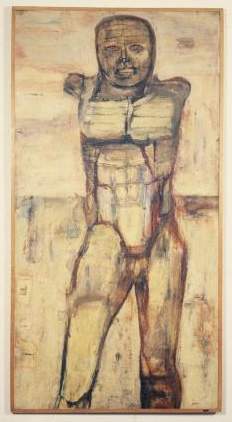
Leon Golub
Orestes 1956
Private collection
Photo © New Museum of Contemporary Art, New York
This was the first one-man exhibition of Golub’s work in Europe. Golub, who was working in Florence at the time – the exhibits were specifically designated ‘paintings done in Italy’ – recalled visiting the Institute of Contemporary Arts in 1956 ‘with a roll of paintings under my arm’ and setting a date for this exhibition the following day.17
In contrast to the mostly abstract American work shown in Britain at this time, Golub’s figurative work bore strong similarities to post-war European artists, as the critic Robert Melville noted in his catalogue text: ‘[Golub’s] pictures emblemize an aesthetic as intransigently as Dubuffet’s portrait of Artaud’.18 Golub was also strongly influenced by classical sculpture (he titled two works in the exhibition Orestes), and was quoted in the catalogue as saying ‘modern man ... can only know the Dionysiac aspects of Greek art – in spite of all his wilful desire for the archaic’.19
8 November – 7 December 1957
Eight American Artists: Paintings and Sculpture
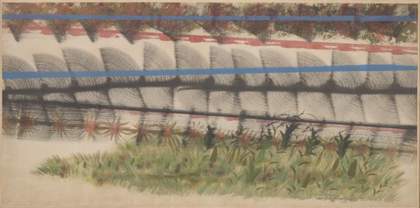
Morris Graves
Spring with Machine Age Noise No. 1 1957
Tempera and ink on paper
Tate T00520
© The estate of Morris Graves
After a visit to Seattle, the British critic Herbert Read recommended an exhibition of painters from the north-west of America to the Arts Council in 1956.20 Eight American Artists: Paintings and Sculpture consisted of four painters with strong ties to Seattle (Guy Anderson, Kenneth Callaghan, Morris Graves and Mark Tobey) and four sculptors based in New York (Rhys Caparn, David Hare, Seymour Lipton and Ezio Martinelli). The Museum of Modern Art in New York declined to loan its works by Tobey and Graves and its curator Dorothy Miller expressed her reservations about the show to her London colleagues. ‘I wish I could tell you specifically how good the exhibition [Seattle Art Museum Director] Dr Fuller selected actually is,’ she wrote, adding that ‘Kenneth Callahan and Guy Anderson are surely less important although they are much admired on the west coast.’21
The artists were selected by the United States Information Agency (USIS) while the individual works were chosen by the Seattle Art Museum. The critic G.M. Butcher lamented this selection policy, writing ‘the inevitable result is Organization Art – art filtered through a series of committees’.22
Eight American Artists toured to the City of York Art Gallery. Reviewing the show in York, A.C. Sewter of the Manchester Guardian wrote that the exhibitors ‘are not perhaps the “Eight American Artists” whom we should most have liked an opportunity of studying in the North of England’, perhaps because the work of Pollock, de Kooning and other New York-based abstract expressionists had yet to be seen there.23 In 1960 another exhibition of American art, Modern American Painting 1930–58, was held in York (City of York Art Gallery, 15 August – 20 September 1960). Again organised by USIS (this time with the City Art Museum of St Louis), this exhibition included twenty-nine artists and provided northern audiences with a broader perspective on American art.
In London the exhibition was opened by US Ambassador John Hay Whitney (who had financed the competition to create a monument to ‘The Unknown Political Prisoner’ in 1953). Shortly before his return to the US, Whitney loaned paintings from his collection for an exhibition at the Tate Gallery (The John Hay Whitney Collection, 16 December 1960 – 29 January 1961).
Morris Graves became one of the first American artists to have a work acquired by the Tate when his Spring with Machine Age Noise No.1 1957 entered the collection in 1962.
19 February – 19 March 1958
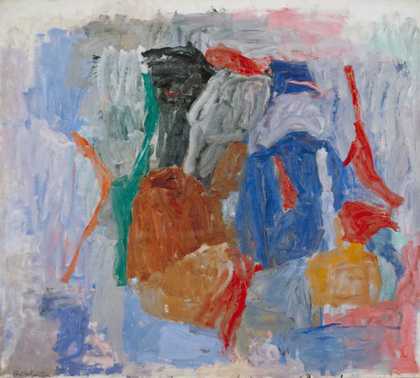
Philip Guston
The Return 1956–8
Oil paint on canvas
Tate T00252
© The Estate of Philip Guston
‘The Department of Fine Art at Nottingham University is to be congratulated on mounting an exhibition of a sort which London is still waiting to see’, wrote the Times art critic of this exhibition, organised by the critic and curator Lawrence Alloway and the artist Harold Cohen (both of whom later moved to the US).24 It was first shown in the Portland Building at Nottingham University alongside an exhibition of impressionist paintings from the collection of Lord Radcliffe. In his foreword to the latter, Alistair Smart, Head of the Department of Fine Art at the university, predicted ‘there are likely to be many ways in which the two Impressionisms, linked as they are historically as well as by name, will illuminate one another’.25
The exhibition was intended to show how a number of contemporary European and American artists, including Sam Francis, Joan Mitchell and Philip Guston, could ‘keep the Impressionist manner of looking at a scene but leave out the scene’, in the words of Elaine de Kooning.26 Several critics, including Jasia Reichardt, admired the show but felt the theme to be ‘arbitrary and synthetic’, perhaps explaining the failure of ‘abstract impressionism’ to become an accepted term.27 Despite Smart’s statement in the Nottingham catalogue that ‘the exhibition will not be shown outside Nottingham’, the exhibition travelled to the Arts Council Gallery in Cambridge, the Laing Art Gallery in Newcastle and the Arts Council Gallery in London. One year later, in 1959, Tate acquired Guston’s The Return 1956–8, which although not in the exhibition, had much in common with works that were.
13 March – 19 April 1958
Some Pictures from the E.J. Power Collection
Institute of Contemporary Arts, London
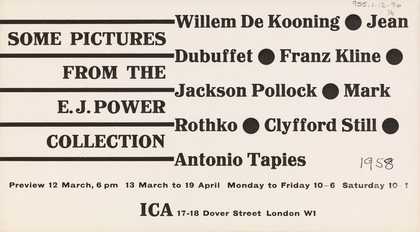
Invitation card for the exhibition Some Pictures from the E.J. Power Collection at the Institute of Contemporary Art, London 1958
Tate Archive TGA 955/1/12/96
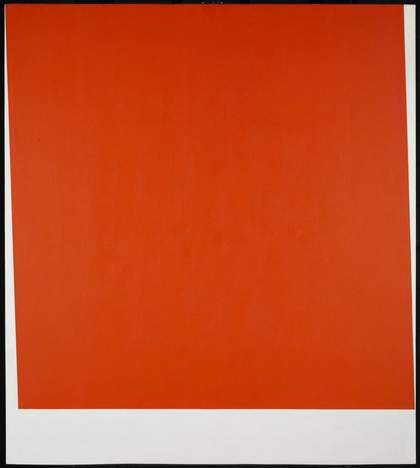
Ellsworth Kelly
Broadway 1958
Tate T00511
© Ellsworth Kelly
The collector E.J. (or Ted) Power bought his first American works in 1956, starting with paintings by Mark Rothko and Sam Francis.28 The 1958 exhibition of some of his collection, organised by Power’s friend the critic and Deputy Director of the Institute of Contemporary Arts Lawrence Alloway, included eleven recently bought works mostly by American artists (Willem de Kooning, Franz Kline, Jackson Pollock, Mark Rothko, Clyfford Still). Alloway’s catalogue introduction began: ‘when asked what the paintings in this exhibition represented to him the collector answered: By gesture or symbol they record man’s reaction to a world teeming with events.’29
Power’s status as the pre-eminent British collector of recent American art was reinforced the following year when he was the only British lender to The New American Painting. In 1958 Power bought eight works from Ellsworth Kelly’s first solo show at the Galerie Maeght in Paris, one of which, Broadway, he presented to Tate in 1962.30
31 October – 21 November 1958
Seventeen American Artists and Eight Sculptors
United States Information Service (USIS) Library, London
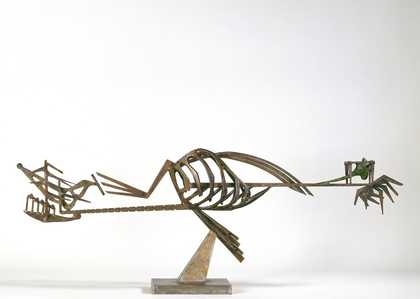
David Smith
The Royal Bird 1947–8
Walker Art Centre
© David Smith Estate/VAGA, New York, NY
This group show provided a British audience with an opportunity to see the work of such artists as Ellsworth Kelly, Ad Reinhardt and David Smith. First presented in the American Pavilion at the 1958 Brussels International Exhibition, it was the first exhibition held at the United States Information Service (USIS) Library, adjacent to the US Embassy in Grosvenor Square, London. Subsequent exhibitions in this venue included Vanguard American Painting (28 February – 30 March 1962), which showed Robert Rauschenberg’s work in the UK for the first time; Abstract Watercolours by Fourteen Americans (6 June – 5 July 1963); and Transatlantics: American Artists Working in Britain (11 May – 3 June 1966).
The USIS Library, which was also a valuable source of recent American art publications, closed in 1966 to the consternation of Spectator editor Iain Macleod, who wrote, ‘it seems hardly an exaggeration to say that the library was possibly the single most important focus of goodwill towards the US in Britain’.31
November – December 1958
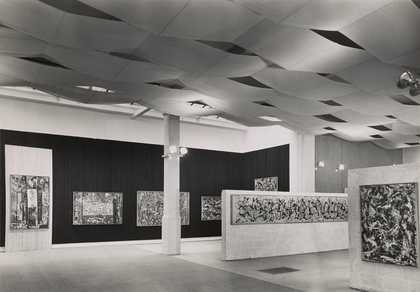
Installation view of the Jackson Pollock exhibition at the Whitechapel Art Gallery, London, 1958
Works © Estate of Jackson Pollock
Photo © Sam Lambert
Held just two years after the artist’s untimely death, this first in-depth showing of Pollock’s work in the UK stirred public excitement and controversy, heightened by the radical installation designed by the architect Trevor Dannatt, which included freestanding breezeblock walls, black panels, footlights and an undulating ceiling of suspended fabric.32 The exhibition included Pollock’s Summertime: Number 9A 1948, subsequently acquired by the Tate Gallery in 1988.
Under the directorship of Bryan Robertson (1953–68), the Whitechapel Gallery held a number of important solo shows by American artists, usually as the British venue for touring exhibitions organised by the Museum of Modern Art, New York. The Pollock show was followed by Mark Rothko (October – November 1961); Mark Tobey (1 January – 4 March 1962), which included Northwest Drift 1958 acquired by the Tate Gallery in 1961; Philip Guston (17 January – 17 February 1963); Robert Rauschenberg (4 February – 8 March 1964); Franz Kline (May – June 1964); Jasper Johns (2–31 December 1964); Morris Louis (June – July 1965); Lee Krasner (22 September – 31 October 1965) and Robert Motherwell (18 March – 17 April 1966).
24 February – 22 March 1959
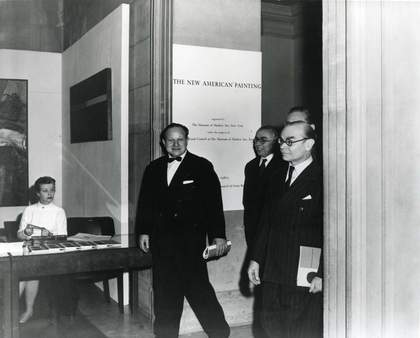
Opening of the exhibition The New American Painting, Tate Gallery, London, 1959, with Tate Director Sir John Rothenstein at far right
Tate Archive Photographic Collection: The New American Painting 1959
Photo © Tate
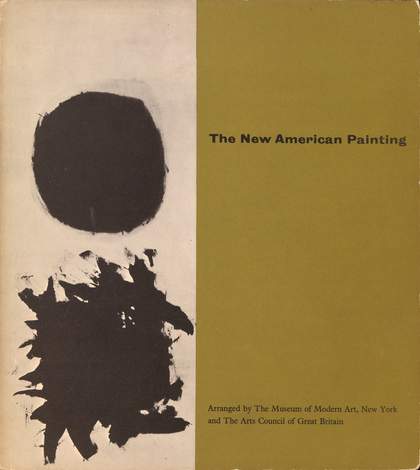
Cover of The New American Painting, exhibition catalogue, Tate Gallery, London 1959
Although the 1956 show Modern Art in the United States had included a room of abstract expressionist paintings, The New American Painting was the first major exhibition of abstract expressionism in Britain and attracted huge press interest.33 Many critics were struck anew by the size and impact of the American works, and were either impressed or repulsed by the way in which they diverged from established aesthetic norms. The critic John Russell, who had reacted strongly against the abstract paintings in the 1956 show, was won round by the time of The New American Painting, although he stressed continuities between the innovations of the abstract expressionists and earlier American painters such as Albert Pinkham Ryder and Marsden Hartley.34
The artists included in this landmark exhibition were William Baziotes, James Brooks, Sam Francis, Arshile Gorky, Adolph Gottlieb, Philip Guston, Grace Hartigan, Franz Kline, Willem de Kooning, Robert Motherwell, Barnett Newman, Jackson Pollock, Mark Rothko, Theodoros Stamos, Clyfford Still, Bradley Walker Tomlin and Jack Tworkov. Alfred Barr, Director of Collections at the Museum of Modern Art, concluded his catalogue essay on a note of pride in the individual and national successes represented by the exhibition: ‘To have written a few words of introduction to this exhibition is an honour for an American who has watched with deep excitement and pride the development of the artists here represented, their long struggle – with themselves even more than with the public – and their present triumph.’35
1959
Tate acquires Mark Rothko’s Light Red Over Black 1957
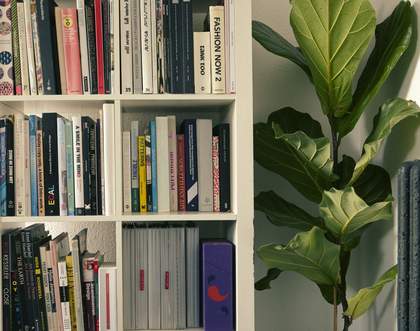
Mark Rothko
Light Red over Black 1957
Tate T00275
© Kate Rothko Prizel and Christopher Rothko/ DACS 2019
Tate’s purchase of Light Red Over Black from The New American Painting exhibition marked the beginning of what would become a lasting relationship between Mark Rothko and Tate, culminating in the artist’s gift of nine paintings (the ‘Seagram Murals’) to the gallery in 1968–9.
Rothko visited London in 1959 as part of a trip around Europe. He went on to visit the painter William Scott in Somerset before travelling to St Ives, where he spent time with artists Peter Lanyon (who threw a huge party in his honour), Alan Davie and Patrick Heron.36
The pace of Tate’s acquisitions of new American art accelerated and included three paintings by Jackson Pollock over the next two years.
1959
R.B. Kitaj begins studying at Royal College of Art, London
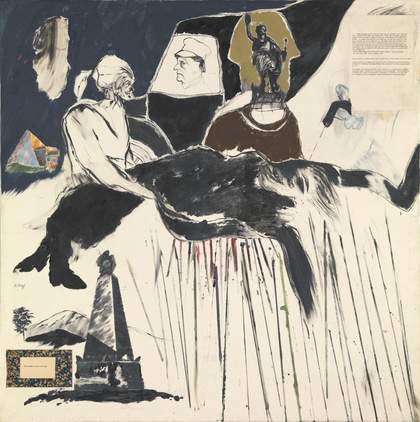
R.B. Kitaj
The Murder of Rosa Luxemburg 1960
Tate T03082
© The estate of R.B. Kitaj
In 1959 the American artist R.B. Kitaj (1932–2007) enrolled at the Royal College of Art (RCA) in London, where he became close with artists such as David Hockney. Before this, he had studied at the Academy of Fine Art in Vienna in 1951, and the Ruskin School of Art in Oxford in 1958–9, having moved to the UK in 1957.
Painted in Kitaj’s first year at the RCA, The Murder of Rosa Luxemburg 1960 was acquired by Tate from the committed collector of American art E.J (or Ted) Power in 1980. In a letter dated August 1982 sent to Tate staff after the acquisition, Kitaj described the painting as his ‘first political picture’, adding that the canvas ‘is about an historic murder but it is really about killing Jews, which is what brought my grandmothers to America’.37
